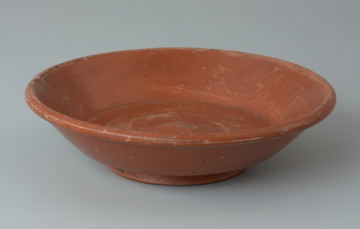
Terra-sigilata vessel, clay, Gronowo, Drawsko poviat
National Museum in Szczecin
Part of the collection: Antiquity
The presented two-handled clay vase served as an urn in a burial discovered in a cemetery of the Wielbark culture in Drawsko Pomorskie. This burial was also equipped with an antler comb. This type of vessel, as most of the pottery from the period of Roman influence, often have a broad chronology. For this reason, the presented vase from Drawsko was dated on the basis of morphological features of the mentioned comb to the 1st/2nd century. Pottery vessels are in general more broadly dated, unlike the ornaments or elements of garments which changed their form much more rapidly. The body of the vase is decorated with a horizontal band of triangles, which are alternately roughened and smoothed. It is a characteristic element of the pottery of the Wielbark culture. Such ornamentation found in neighbouring areas, such as west of the Oder, is thought to be the result of the influence of the Wielbark culture on the local communities. The cemetery in Drawsko was probably discovered in 1906 during the extraction of sand and gravel for the construction of a narrow-gauge railroad. The discovery of the first grave was documented in the next year. Due to further reports of archaeological discoveries, Adolf Stubenrauch, a conservator-restorer from Szczecin, initiated excavations of the cemetery to rescue the finds. He uncovered a total of eight burials. Further rescue excavations were carried out by Bernhard Faust, a teacher from Drawsko and an amateur archaeologist. He was at the same time appointed social guardian of historical monuments by the conservator in Szczecin in the then Drawsko district. Based on the preserved documentation and archives, about 70 graves can be identified, most of them cremation burials, but also some inhumation ones. This situation is typical for cemeteries of the Wielbark culture between the 1st and 3rd centuries.
Bartłomiej Rogalski
Author / creator
Dimensions
cały obiekt: height: 24.1 cm, width: 25 cm
Object type
furnishings and equipment; container; vessel (container); funerary vessel
Technique
manual modelling
Material
clay
Creation / finding place
Owner
Muzeum Narodowe w Szczecinie
Identification number
Location / status

National Museum in Szczecin

National Museum in Szczecin

National Museum in Szczecin
DISCOVER this TOPIC
National Museum in Szczecin
DISCOVER this PATH
Educational path